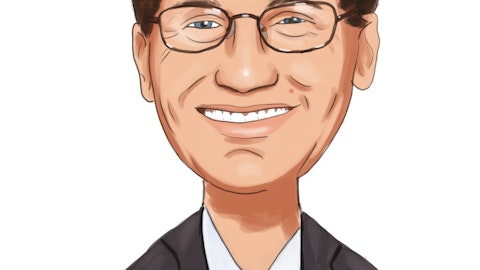Federated Hermes, Inc. (NYSE:FHI) Q3 2023 Earnings Call Transcript October 27, 2023
Operator: Greetings. Welcome to the Federated Hermes, Inc. Q3 2023 Analyst Call and Webcast. At this time, all participants are in a listen-only mode. A question-and-answer session will follow the formal presentation. [Operator Instructions] Please note this conference is being recorded. I will now turn the conference over to your host, Ray Hanley, President of Federated Investors Management Company. You may begin.
Ray Hanley: Good morning, and welcome. Thank you for joining us today. Leading today’s call will be Chris Donahue, Federated Hermes President and CEO; and Tom Donahue, Chief Financial Officer. And joining us for the Q&A are Saker Nusseibeh, who is the CEO of Federated Hermes Limited, our international operation; and Debbie Cunningham, the Chief Investment Officer for the money markets. During the call, we may make forward-looking statements, and we want to note that Federated Hermes actual results may be materially different than the results implied by such statements. Please review the risk disclosures in our SEC filings. No assurance can be given as to future results, and Federated Hermes assumes no duty to update any of these forward-looking statements. Chris?
Chris Donahue: Thank you, Ray, and good morning all. I will review Federated Hermes business performance, Tom will comment on the financial results. We had solid asset growth in Q3, ending with record assets under management of $715 billion, driven by record money market assets of $525 billion. Fixed income produced solid growth as well. Looking first at equities. Assets were down $5.7 billion to $77.3 billion, due to combined market losses and FX impact totaling $3.3 billion and net redemptions of $2.4 billion. We did see Q3 positive net sales in 14 equity strategies, including MDP large cap growth, international leaders and U.S. SMID equity. The strategic dividend domestic strategy had Q3 net redemptions of $1.5 billion. This strategy is outcome-driven and is benchmark agnostic as we have said each quarter.
It seeks a high and rising stream of dividend income from high-quality companies. As of 9/30, the fund had a weighted average dividend yield of 5.1%, compared to a 1.6% yield in the S&P and the fund has seen 39 dividend increases and zero cuts in the trailing 12-months. Looking at equity performance, compared to peers and using Morningstar data for the trailing three years end of Q3, 54% of our equity funds were beating peers and 33% were in the top quartile of their category. For the first three weeks of Q4, combined equity funds and SMAs on the equity side had net redemptions of $753 million. Now turning to fixed income. Assets increased by $2.3 billion in Q3 to $89.8 billion with fixed income separate accounts reaching a record high of $47.2 billion.
Fixed income institutional separate account net sales of $3.8 billion were driven by the funding of a $2 billion in an institutional multi-sector mandate and by approximately $1.3 billion from a large public entity. Fixed income SMAs had Q3 record gross and net sales of $572 million and $320 million, respectively. Fixed income funds had net redemptions of about $684 million. Within funds, our flagship Core Plus strategy, total return bond fund had Q3 net sales of about $466 million. So that includes both the fund and the CIT. Core Plus funds and other fixed income SMA strategies added $320 million of Q3 sales. The three Ultrashort funds posted net redemptions of about $462 million. We had 15 fixed income funds with positive net sales in the third quarter, including the Total Return Bond Fund, the total return bond collective investment fund, the intermediate Corporate Bond Fund and the Sterling Cash Plus.

Regarding performance, at the end of Q3 and using Morningstar data for the trailing three years, 31% of our fixed income funds were beating peers; 17% were in the top quartile of their category. For the first three weeks of Q4, fixed income funds and SMAs had net redemptions of $77 million. In the alternative private markets category, assets decreased by about $1.3 billion in the third quarter from the prior quarter came to $20.3 billion. The decrease was due to FX impact of about just under $800 million, market value decreases of about $300 million and net redemptions and distributions of about $200 million. We are in the market with Horizon 3, the third vintage of our Horizon series of global private equity funds. Horizon 3 has closed on commitments of $1.05 billion through the third quarter.
We’re also in the market with the Hermes Innovation Fund II, the second vintage of our pan-European growth private equity Innovation Fund. We had our first close in August for approximately EUR100 million, and we’re in the market with our first vintage of our U.K. Nature Impact Fund. We began Q4 with about $4.9 billion in net institutional mandates yet to fund in both funds and separate accounts. These wins are diversified across fixed income, equity and private markets. Fixed income expected additions totaled about $3.1 billion, which include wins in active cash, short credit, high yield and corporates. Approximately $1.5 billion of total net wins is expected to come in private market strategies with wins in private equity, direct lending and absolute return.
About $227 million of the net total wins is expected to come into equity strategies and wins included mandates in bio equity, global equity and gems. Moving to money markets. We reached record highs for the money market assets of $385 billion, and total money market assets of $525 billion. Money market strategies continue to benefit from favorable market conditions for cash as an asset class, higher yields, elevated liquidity levels in the financial system and, of course, favorable yields, compared to bank deposits. A short-term interest rates peak, we expect market conditions for money market strategies will be favorable compared to both direct market rates and bank deposit rates. Looking at flows in money market funds in the third quarter, we saw good activity from products geared towards the retail customers of financial intermediaries.
Institutional product flows continue to be challenged by direct security yields. Our estimate of money market mutual fund market share including sub-advised funds was about 7.3% at the end of the third quarter, up from about 7.2% at the end of the second quarter. Looking at recent asset totals as of a few days ago, managed assets were approximately $716 billion, including $527 billion in money markets; $74 billion in equities; $91 billion in fixed income; $20 billion in alternative private markets; and $3 billion in multi-asset. Money market mutual fund assets were at $385 billion. Tom?
Tom Donahue: Thanks, Chris. Total revenue for Q3 decreased $30.6 million from the prior quarter due mainly to the substantial carried interest and performance fees in Q2 related to the transactions we discussed on our last call. Q3 carried interest and performance fees were $14.9 million, compared to $39.4 million in the second quarter. All other revenue decreased by $6.1 million. Revenue from money market assets decreased by $9 million, offset by an $8.2 million decrease in related distribution expense. Changes in certain product structures drove these decreases, while higher average money market assets added to revenue. Q3 operating expenses decreased $33.6 million from the prior quarter due mainly to compensation related to carried interest and performance fees in Q2.
We and to lower money market fund distribution fees as discussed. Q3 included about $10 million in compensation related to carried interest. The decrease in other operating expenses includes a reduction of about $7 million in expense related to the infrastructure fund restructuring discussed in Q2 and partially offset by an increase of $3.7 million in FX-related costs and approximately $2 million of other expenses. At the end of Q3, cash and investments were $554 million, of which about $486 million was available to us. Holly, that completes our prepared remarks, and we would like to open the call up for questions now.
See also What is a Covered Call? 10 Best Stocks For Covered Calls and 80 Dirty Funny Tinder Bios for Guys from Reddit .
Q&A Session
Follow Federated Hermes Inc. (NYSE:FHI)
Follow Federated Hermes Inc. (NYSE:FHI)
Operator: Certainly. At this time we will conducting a question-and-answer session. [Operator Instructions] Your first question for today is coming from Dan Fannon at Jefferies.
Dan Fannon: Thanks, good morning.
Chris Donahue: Good morning.
Dan Fannon: I wanted to discuss your outlook for money market assets and in the context of rates. I think we’ve heard from others that fixed income is as rates peak is going to see a significant demand pick up, and I think you’re talking about money markets as being also a beneficiary. So wondering what’s the as we think about duration maybe being extended, how money markets you think will fare in terms of demand versus what would be more traditional fixed income asset classes?
Chris Donahue: I will comment on it first and then Debbie will have some additional comments. But as we said on this call over the last several calls, that once those rates begin to peak, you begin to attract the institutional money, which is — as I mentioned, is more attracted by direct securities at this point in time. And so we would expect to see institutional flows increase. But right now, on the retail side, that’s — we’re in a very good position with the rates and when you combine that with the reticence of financial advisers to take positions, their lack of certainty, they’re waiting on the Fed and getting paid 5%-plus. It’s hard to say exactly when they will decide to go longer. But that would be the basic outlook.
And don’t forget that as we’ve mentioned before, when we look at the last cycles from ’16 to ’18, Q4 of ’16 — Q4 of ’16, Q4 of ’18, after the initial decline, the money market fund assets increased by 15% and then industry did about the same about 11%. And we continue to grow with higher rates, of course. And then the other thing we like to mention is that, basically, our assets grew about over 20% through Q3 of ’19 when they began to ease. And the industry assets also grew at a smart clip then. So that’s the basis on which we come to those kinds of observations. Debbie?
Debbie Cunningham: Sure. I’ll just add a couple of things. You mentioned, Dan, the extension trade, and we do that even within money markets. So started out this cycle with weighted average maturities durations down in the single-digits to teens from a day’s perspective, we’re now out much longer, 30, 40, 45 types days have done the extension trade in order to keep the yields higher within the product itself. I think another thing that’s helpful is that during the zero rate environment, so many cash managers got used to bucketing cash. So a certain amount that’s kind of operating on a day-to-day stays in the government sector. Next kind of more strategic go out into prime and then ultimately, Microshort — Ultrashort in the longest bucket.
But when you’re looking at a higher for longer scenario with a yield curve that from overnight say 5.25% to 5.30% out to 10-year bonds at just under at just under 5%, you’re looking at something that is a market that’s finally reconciling with that Fed statement higher for longer. So I think the flows, as Chris mentioned, we’ll continue in retail, and we’ll do nothing, but grow in institutional.
Ray Hanley: And Dan, it’s Ray. I would just add, we’re well positioned for people deciding to extend out on the curve with our fixed income product array. And in particular, people are interested as evidenced by the flows in our total return bond Core Plus strategy with a six-year weighted average effective duration. It’s really well positioned. We’ve been talking to clients all year. The cash yields are very attractive. So it’s — there is a certain amount of waiting for the right time. But when that trade happens, we have a lot of good strategies that can catch the money going out further.





